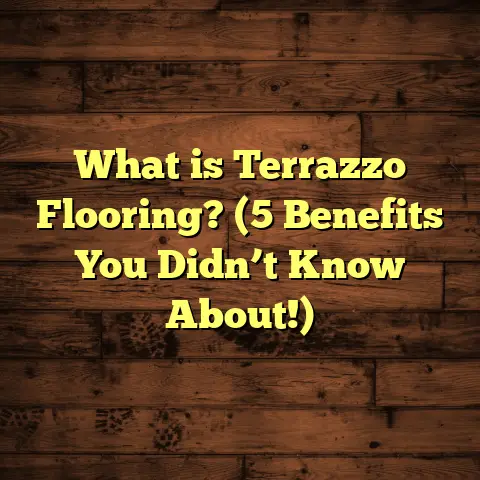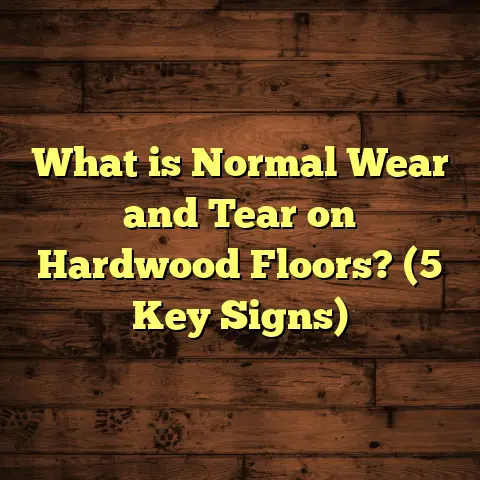What is Hard Surface Flooring? (5 Key Benefits You Should Know!)
Introduction: The Ease of Caring for Hard Surface Flooring
Have you ever noticed how some floors just seem to stay clean no matter what? That’s exactly what attracted me to hard surface flooring years ago. I remember the chaos in my own home when spills and mud tracked in by the kids would wreak havoc on the carpet. Cleaning carpets felt like a never-ending chore — vacuuming multiple times a week, scrubbing stubborn stains, dealing with odors. It was exhausting.
Hard surface flooring changed all that for me. I quickly realized that these floors are not only easier to maintain but also look great for years. They don’t trap dust or allergens, which means less sneezing and coughing around the house. And the best part? You can clean them up with a simple sweep and mop.
If you’re considering new floors or want to understand what hard surface flooring really is, I’m here to share everything I’ve learned from years of installing and living with it. Let’s start by defining what hard surface flooring actually means.
What Is Hard Surface Flooring?
Hard surface flooring covers any floor made from rigid materials instead of soft ones like carpet or rugs. This includes wood, tile, stone, laminate, vinyl, and composite materials. The key characteristic is its solid, durable nature that can withstand heavy use and resist damage better than softer floorings.
The Main Types of Hard Surface Flooring
Each type comes with unique manufacturing processes and features:
- Hardwood Flooring: This is natural wood harvested from trees. It’s cut into planks or strips, kiln-dried to reduce moisture content (usually between 6-9%), then sanded and finished with oils or polyurethane coatings for protection. Hardwood is known for its warmth and character because of the natural grain patterns in wood.
- Engineered Hardwood: A more modern take on hardwood. It consists of layers: a hardwood veneer on top of plywood or high-density fiberboard (HDF). This design makes it more dimensionally stable in humid environments compared to solid hardwood.
- Laminate Flooring: Made by fusing multiple layers under high heat and pressure. At its core is HDF or fiberboard, topped by a photographic layer mimicking wood or stone, then sealed with a clear melamine resin wear layer. Laminate is cost-effective and resistant to scratches.
- Vinyl Flooring: Manufactured by layering PVC sheets, including a backing layer, a design film layer printed with realistic patterns, a foam or felt core for cushioning, and a tough wear layer on top. Vinyl is waterproof and versatile, available in planks or tiles.
- Tile Flooring: Usually ceramic or porcelain made from clay mixed with minerals, fired at very high temperatures (1200–1400°C). Porcelain is denser and less porous than ceramic, making it more durable and water-resistant. Tiles come in various finishes—matte, glossy, textured.
Understanding Hardness & Durability Ratings
Different floors have different hardness levels important for durability:
- Janka Hardness Test: Measures wood’s resistance to denting by pressing a steel ball into the wood surface. For example:
- Red Oak: 1290 (common hardwood choice)
- Hickory: 1820 (very hard)
- Brazilian Cherry: 2350 (extremely hard)
- AC Ratings for Laminate: AC1 (light residential) to AC5 (heavy commercial). The higher the AC rating, the more durable the laminate.
- Mohs Scale for Tile: Measures scratch resistance on scale 1-10. Most ceramic/porcelain tiles rank between 6-7.
Manufacturing Insights
Each type is created through precise industrial processes:
- Hardwood planks are sawn from logs into specific thicknesses (usually 3/4 inch), dried in kilns to stabilize moisture content for preventing warping after installation.
- Laminate flooring layers are fused at high temperatures (over 300°F) using melamine resins and adhesives to create a strong bond that resists delamination.
- Vinyl flooring uses calendaring or extrusion methods where PVC compounds are heated and formed into thin sheets before printing patterns and applying protective layers.
- Tile production involves shaping clay into tiles via pressing or extrusion followed by firing in kilns at extreme heat to vitrify the material—making it hard and water-resistant.
Why I Prefer Hard Surface Floors: 5 Benefits You Should Know
Over my years working as a flooring contractor and remodeling homes, I’ve seen firsthand why hard surface flooring is often the best option for many homeowners. Let me walk you through five benefits that stand out.
1. Durability That Holds Up Over Time
Durability has always been a top priority in my projects. Homeowners want floors that look good today and still perform well decades later.
Hardwood floors can last over 100 years when properly maintained. The natural fibers in hardwood are tough against scratches and dents—especially species like hickory or maple. And if damage does occur, hardwood can be sanded and refinished multiple times to restore its original beauty.
Laminate flooring is engineered for resilience with wear layers designed to withstand scratches from pets’ claws or moving furniture. I once installed laminate in a busy daycare center where kids ran around all day—after four years, the floors looked nearly brand new.
Vinyl flooring is prized for its water resistance and toughness. It’s common in kitchens and bathrooms where moisture can ruin other floor types. Luxury vinyl plank (LVP) products mimic wood but hold up better against spills and humidity.
Tile floors are incredibly hard-wearing. Porcelain tiles resist chipping better than ceramic thanks to their dense composition. In commercial spaces like restaurants or retail stores I’ve worked on, tiles keep looking fresh despite heavy foot traffic.
2. Easier to Clean and Maintain
One reason I recommend hard surface floors so often is how much easier they are to clean compared to carpet.
Carpet traps dirt, dust mites, pet dander, and spills that soak into fibers—making deep cleaning necessary regularly. Hard surface floors don’t hold onto these particles; instead, crumbs and dust sit on top where you can sweep or vacuum them away easily.
I remember visiting a client who had just switched from wall-to-wall carpet to engineered hardwood throughout their main living spaces. They told me they saved hours every week on cleaning alone because spills wiped up instantly without staining.
Vinyl and tile require minimal maintenance—just regular sweeping and damp mopping. Unlike wood, they don’t need refinishing or special cleaners beyond mild detergent solutions.
3. Versatile Design Options for Any Style
Have you ever felt stuck picking flooring because you were afraid it wouldn’t match your décor? Hard surface floors offer an amazing range of choices so you never have to compromise style.
Hardwood comes in dozens of species with varied grain patterns—from classic oak to exotic Brazilian walnut. You can choose finishes ranging from glossy to matte or distressed looks that add rustic charm.
Laminate flooring now features hyper-realistic photographic layers that mimic wood grain or stone textures almost perfectly—even under close inspection. Plus, it comes in many plank sizes and colors.
Vinyl planks let you create almost any look imaginable—from traditional hardwood styles to slate or marble patterns—in waterproof formats ideal for kitchens or bathrooms.
Tiles come in countless shapes, sizes, colors, and finishes—from tiny mosaic tiles used as backsplashes to large-format porcelain slabs that make rooms appear bigger.
In one renovation project I did recently, the client wanted a Scandinavian minimalist look with pale wood tones paired with concrete countertops. We chose light ash hardwood flooring finished matte—it complemented the clean aesthetic perfectly while adding warmth underfoot.
4. Better Indoor Air Quality
If anyone in your family struggles with allergies or respiratory problems, this benefit alone might convince you to switch your floors.
Carpets harbor allergens like dust mites, mold spores trapped deep inside fibers—and even bacteria if spills aren’t cleaned promptly. These irritants circulate every time you walk or vacuum over them.
Hard surface floors don’t trap allergens but allow them to be removed easily through simple cleaning routines. Studies have shown homes with hard flooring experience lower rates of asthma attacks and allergic reactions compared to carpeted homes.
I have several clients who switched from carpet to hardwood specifically after noticing allergy symptoms worsen during winter months—once the change was made, they reported better breathing comfort overall.
5. Strong Resale Value
From everything I’ve seen flipping homes or helping clients prepare properties for sale—hard surface floors add real value.
Buyers tend to associate hardwood floors with quality craftsmanship and longevity. Homes with well-maintained hard surface flooring often sell faster and command higher prices than those with old or stained carpets.
According to Remodeling Magazine’s Cost vs. Value Report, refinishing hardwood floors has an average return on investment of over 70%, far exceeding other remodeling projects like kitchen upgrades.
Even vinyl plank flooring has gained popularity among buyers who want cost-effective but modern looks—and it adds appeal compared to carpeted rentals.
More About Manufacturing Processes & Technical Specifications
Understanding how various hard surface floors are made helps explain their performance characteristics:
Hardwood Flooring Details
- Moisture Content: Kiln drying reduces moisture from 30% in raw wood down to about 6-9% before installation to prevent warping.
- Finish Types: Oil-based polyurethane creates a durable glossy layer; water-based finishes dry quicker with less odor but slightly lower durability.
- Board Dimensions: Common widths range from 2¼ inches (traditional strip) up to wide planks of 7+ inches.
Laminate Construction Layers
- Core Layer: High-density fiberboard providing stability.
- Decorative Layer: High-resolution photographic image of wood or stone.
- Wear Layer: Clear melamine resin that resists abrasion.
- Backing Layer: Protects against moisture from below.
Vinyl Flooring Technology
- Wear Layer Thickness: Ranges from 6 mils (light residential) up to 40 mils (heavy commercial).
- Print Layer: High-definition UV printing renders realistic textures.
- Cushioning: Some luxury vinyl includes foam underlayment for comfort.
Tile Manufacturing Facts
- Porcelain Tile: Fired longer at higher temps; less porous (<0.5% water absorption).
- Ceramic Tile: Fired at lower temp; more porous (~3-7% absorption).
- Glazes: Applied before firing; add color and texture while sealing the tile surface.
Personal Stories & Case Studies
I want to share some real-world examples from my projects:
Case Study: Allergy Relief Through Flooring Change
A family in my neighborhood struggled with severe allergies triggered by their wall-to-wall carpeted home. After installing engineered hardwood flooring throughout the living room and bedrooms, they reported a noticeable reduction in sneezing and nighttime congestion within weeks.
Regular cleaning combined with hard surface floors helped reduce airborne allergens significantly compared to before.
Story: Commercial Vinyl Flooring Endurance
I installed luxury vinyl plank flooring in a busy café serving hundreds daily. The owners appreciated the waterproof feature—it held up despite frequent spills of coffee and food without staining or warping over three years.
The vinyl’s design mimicked natural oak so well customers often complimented the warmth it added without realizing it wasn’t real wood.
Experience: Tile Installation Challenges & Rewards
Tile installation requires precision—especially grout work—to avoid cracking or water seepage later on. On one bathroom renovation, we chose porcelain tile with textured finish for slip resistance around the tub area.
Sealing the grout lines properly prevented mold growth over years of use—a crucial step often overlooked by DIYers but essential for long-term success.
Data & Research Supporting Hard Surface Floors
Here are some important data points supporting hard surface flooring benefits:
| Statistic/Study | Key Takeaway |
|---|---|
| National Wood Flooring Association (NWFA), U.S., 2022 | Hardwood sales up 20% since 2015 due to durability demand |
| Journal of Allergy & Clinical Immunology | Homes with hard floors show 60% fewer dust mites vs carpet |
| Resilient Floor Covering Institute | Vinyl flooring market growing at ~4% annually worldwide |
| Remodeling Magazine Cost vs Value Report | Hardwood refinishing ROI averages over 70% |
These figures back up what I see daily—hard surfaces remain popular because they meet homeowner needs practically and aesthetically.
How To Choose Your Hard Surface Floor?
Choosing can feel overwhelming because options are vast. Here’s what I ask clients:
- What room are you installing it in? Bathrooms need waterproof; living rooms may prioritize warmth.
- How much foot traffic? Busy areas need tougher materials.
- Do you have pets? Scratch resistance matters.
- What style do you prefer? Rustic wood or sleek tile?
- Budget considerations? Laminate often costs less than hardwood.
- Allergy concerns? Hard surfaces help here.
Answering these helps narrow choices quickly:
| Room Type | Recommended Flooring Type(s) | Notes |
|---|---|---|
| Kitchen/Bathroom | Vinyl (LVP/LVT), Porcelain Tile | Waterproof surfaces essential |
| Living Room/Dining | Hardwood, Engineered Hardwood | Warmth & aesthetics prioritized |
| Basement | Vinyl Plank, Laminate (with moisture barrier) | Moisture resistance needed |
| High Traffic Areas | Laminate AC4+, Vinyl Commercial Grade | Durability over style |
Installation Insights & Tips from Experience
Installation quality impacts floor longevity more than most realize:
- Hardwood requires acclimation onsite for at least 48 hours to adjust moisture levels.
- Laminate must be installed as floating floors over moisture barriers if placed on concrete slabs.
- Vinyl planks often feature click-lock systems for DIY-friendly installs but need smooth subfloors.
- Tile setting needs correct mortar type, grout sealing, and expansion joints.
I always tell clients: don’t skimp on professional installation if unsure—it pays off in fewer problems down the road.
Maintenance Tips That Keep Floors Looking New
Even durable floors need care:
Hardwood
- Clean with pH-neutral wood floor cleaner.
- Avoid excess water; wipe spills immediately.
- Use felt pads under furniture legs.
- Refinish every 7–10 years depending on wear.
Laminate
- Dry mop daily.
- Use damp mop occasionally; avoid soaking.
- Don’t wax or polish laminate surfaces.
Vinyl
- Sweep regularly.
- Clean spills immediately.
- Use manufacturer-approved cleaners.
Tile
- Sweep debris out daily.
- Mop grout lines periodically with grout cleaner.
- Seal grout every year or two.
Environmental Impact & Sustainability
Sustainability is on many minds now:
- Hardwood from FSC-certified forests ensures responsible harvesting.
- Some manufacturers produce laminate using recycled wood fibers.
- Vinyl production involves PVC which raises environmental questions; however newer recycling programs improve this.
- Porcelain tile is made from natural materials but requires significant energy during firing phase.
Choosing environmentally friendly products depends on certifications like FSC (for wood) or GreenGuard (for low VOC emissions).
Final Thoughts on Hard Surface Flooring
After all these years installing floors in hundreds of homes and businesses—hard surface flooring remains my favorite recommendation for many reasons: durability, easy care, design flexibility, health benefits, and value retention.
If you want floors that withstand life’s messes while adding beauty to your space—you won’t regret choosing hard surface options.
Feel free to ask me about specific materials or installation tips—I’m here anytime!





